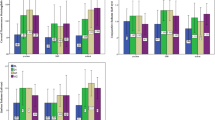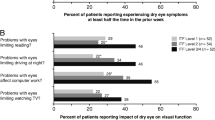Abstract
Purpose
Glare visual acuity and contrast sensitivity are important indicators of visual quality. Studies have shown that the glare visual acuity and contrast sensitivity in dry eye patients tend to degenerate, further affecting their quality of life. The objective of this study was to investigate the effect of notch filters on glare VA and contrast sensitivity in patients with dry eye or with dry eye syndrome.
Method
36 subjects in the 20‒65 age group were diagnosed as having dry eye disease or perceived dry eye syndromes themselves who were included after the initial screening with the OSDI questionnaire, and one was subsequently excluded as they had undergone retinal detachment surgery. Finally, 35 subjects (14 male and 21 female) with a mean age of 40.66 ± 15.62 years participated in this study. All subjects wore their habitual prescriptions and four different filter lenses (namely 480, 620, dual 480 & 620 notch filter, and FL-41 tinted lens), and measured the parameters of glare visual acuity and contrast sensitivity using CSV-1000 and sine wave contrast test (SWCT), respectively. Student t-test and Repeated measurement analysis (R-ANOVA) were utilized by using SPSS 26.0 software.
Results
A dual-wavelength 480 & 620 nm optical notch filter had a significant anti-glare effect decreasing glare disabilities or discomfort, and leading to better visual quality, the same effect was also shown on a 480 nm notch filter lens. All participants showed a significant difference among the baseline, three notch filters (480 nm, 620 nm, dual-wavelength 480 & 620 nm), and FL-41 tinted lens were used on SWCT_A (1.5 cpd, F = 3.054, p = 0.019) and SWCT_E (18 cpd, F = 2.840, p = 0.049); but did not show statistical different on SWCT_B (3 cpd, F = 0.333, p = 0.771), SWCT_C (6 cpd, F = 1.779, p = 0.159), and SWCT_D (12 cpd, F = 1.447, p = 0.228).
The baseline showed the best visual performance on CS at a low spatial frequency (SWCT_A, 1.5 cpd), any filter might reduce the contrast sensitivity at low spatial frequencies in the clinical trial, whereas 480 nm notch filter showed the best effectiveness on CS at a high spatial frequency (SWCT_E, 18 cpd), the FL-41 lens that also filters out the 480 nm band does not achieve the same effect. Moreover, patients with dry eye or those older than 40 years old preferred optical multilayer notch filters to FL-41 tinted lenses.
Conclusion
The 480- & 620-nm dual-wavelength and 480-nm single-wavelength notch filters have the best effect on the glare visual acuity and contrast sensitivity (CS) at high spatial frequencies in dry eye patients. The 620-nm notch filter performs better in CS at low and mid-low spatial frequencies; the FL-41 tinted lens performs poorly for glare VA and CS spatial frequencies examination. Patients with glare disabilities or CS disturbance at high spatial frequencies may choose a 480-nm notch filter lens, and patients who have CS disturbance at low spatial frequencies may consider a 620-nm notch filter for the prescription.





Similar content being viewed by others
Data and materials availability
All data generated or analyzed during this study are included in this published article and its supplementary information files. Correspondence and requests for materials should be addressed to C.-Y.C.
References
Uchino M et al (2013) Prevalence of dry eye disease and its risk factors in visual display terminal users: the Osaka study. Am J Ophthalmol 156(4):759–766
Liou and Chen (1997) Prevalence of dry eye in ophthalmic outpatients. Department of ophthalmology Taipei Jen-Ai Municipal Hospital, 36: 356–360
Uchino M et al (2008) Japan ministry of health study on prevalence of dry eye disease among Japanese high school students. Am J Ophthalmol 146(6):925–929
Zhang Y, Chen H, Wu X (2012) Prevalence and risk factors associated with dry eye syndrome among senior high school students in a county of Shandong Province. China Ophthalmic epidemiology 19(4):226–230
Uchino M et al (2011) Prevalence and risk factors of dry eye disease in Japan: Koumi study. Ophthalmology 118(12):2361–2367
Moon JH, Kim KW, Moon NJ (2016) Smartphone use is a risk factor for pediatric dry eye disease according to region and age: a case control study. BMC Ophthalmol 16:1–7
Liu Nn et al. (2014) Prevalence of and risk factors for dry eye symptom in mainland china: a systematic review and meta-analysis. J Ophthalmol
Huang F-C et al (2002) Effect of artificial tears on corneal surface regularity, contrast sensitivity, and glare disability in dry eyes. Ophthalmology 109(10):1934–1940
Montés-Micó R, Cáliz A, Alió JL (2004) Wavefront analysis of higher order aberrations in dry eye patients. 2004, Slack Incorporated Thorofare, NJ. p. 243–247
Katz BJ, Digre KB (2016) Diagnosis, pathophysiology, and treatment of photophobia. Surv Ophthalmol 61(4):466–477
Stringham JM, Fuld K, Wenzel AJ (2003) Action spectrum for photophobia. JOSA A 20(10):1852–1858
Stringham JM, Fuld K, Wenzel AJ (2004) Spatial properties of photophobia. Invest Ophthalmol Vis Sci 45(10):3838–3848
Lebensohn JE (1951) Photophobia: mechanism and implications. Am J Ophthalmol 34(9):1294–1300
RIDDER III WH, Tomlinson A, Paugh J (2005) Effect of artificial tears on visual performance in subjects with dry eye. Optom Vision Sci 82(9): 835–842
Rolando M et al (1998) Low spatial-contrast sensitivity in dry eyes. Cornea 17(4):376–379
Ridder WH III et al (2009) Contrast sensitivity and tear layer aberrometry in dry eye patients. Optom Vis Sci 86(9):E1059–E1068
D’Zmura M, Lennie P (1986) Shared pathways for rod and cone vision. Vision Res 26(8):1273–1280
Jackowski MM et al (1996) Photophobia in patients with traumatic brain injury: uses of light-filtering lenses to enhance contrast sensitivity and reading rate. NeuroRehabilitation 6(3):193–201
Hoggan RN et al (2016) Thin-film optical notch filter spectacle coatings for the treatment of migraine and photophobia. J Clin Neurosci 28:71–76
Blackburn MK et al (2009) FL-41 tint improves blink frequency, light sensitivity, and functional limitations in patients with benign essential blepharospasm. Ophthalmology 116(5):997–1001
Bass M et al. (1995) Optical properties of films and coatings. Handbook of optics 4
Macleod H (2010) Thin-film optical filters. CRC Press, USA
Zhang J et al (2013) Design and fabrication of ultra-steep notch filters. Opt Express 21(18):21523–21529
Tien C-L et al (2022) Design and fabrication of a cost-effective optical notch filter for improving visual quality. Coatings 12(1):19
Sunjic-Alic A, Zebenholzer K, Gall W (2021) Reporting of studies conducted on Austrian claims data. Navigating Healthcare Through Challenging Times. IOS Press, pp 62–69
Cuschieri S (2019) The STROBE guidelines. Saudi J Anaesth 13(Suppl 1):S31
Lee JH et al (2020) Correlation analysis between ocular surface parameters with subjective symptom severity in dry eye disease. Korean J Ophthalmol: KJO 34(3):203
Wajuihian SO (2015) Frequency of asthenopia and its association with refractive errors. Afric Vis Eye Health 74(1):7
Prabhu PB, Faseena N, Raju K (2016) Role of refractive errors in inducing asthenopic symptoms among spectacle corrected ammetropes. BMH Medi J-ISSN 2348–392X, 3(2): 32–36
Ginsburg AP (2003) Contrast sensitivity and functional vision. Int Ophthalmol Clin 43(2):5–15
Chellappa SL et al (2014) Photic memory for executive brain responses. Proc Natl Acad Sci 111(16):6087–6091
Mure LS et al (2009) Melanopsin bistability: a fly’s eye technology in the human retina. PLoS ONE 4(6):e5991
Mure LS et al (2007) Melanopsin-dependent nonvisual responses: evidence for photopigment bistability in vivo. J Biol Rhythms 22(5):411–424
Pateras E, Karioti M (2020) Contrast sensitivity studies and test-A review. Int J Ophthalmol Clin Res 7(116):1–7
Shandiz JH et al (2011) Effect of cataract type and severity on visual acuity and contrast sensitivity. J Ophthalmic Vis Res 6(1):26
Hess R, Woo G (1978) Vision through cataracts. Invest Ophthalmol Vis Sci 17(5):428–435
Ginsburg A, Tedesco J (1986) Evaluation of functional vision of cataract and yag posterior capsulotomy patients using the Vistech contrast sensitivity chart. Invest Ophthal Vis Sci 27(3):107
Stern CD (2011) Photophobia, light, and color in acquired brain injury. Vision Rehabilitation, 2011: p. 283–300
Uchino M, Schaumberg DA (2013) Dry eye disease: impact on quality of life and vision. Current ophthalmol Reps 1:51–57
Keane PA et al (2010) Effects of retinal morphology on contrast sensitivity and reading ability in neovascular age-related macular degeneration. Invest Ophthalmol Vis Sci 51(11):5431–5437
Lövestam-Adrian M, Svendenius N, Agardh E (2000) Contrast sensitivity and visual recovery time in diabetic patients treated with panretinal photocoagulation. Acta Ophthalmol Scand 78(6):672–676
Acknowledgements
Authors are grateful for the Precision Instrument Support Center of Feng Chia University in providing SPM and SEM analytical facilities.
Funding
This research was funded by Chung Shan Medical University and Feng Chia University research projects FCU-21H00723 and FCU/CSMU 110-003 in Taiwan.
Author information
Authors and Affiliations
Contributions
Conceptualization, CLT, CYC and. SHS; investigation, data curation, and formal analysis, CLT, CYC, SHS, and KCS; writing—original draft preparation, CLT, CYC and SHS; writing—review and editing, CYC, and SHS. All authors have read and agreed to the published version of the manuscript.
Corresponding author
Ethics declarations
Conflict of interest
The authors have no relevant financial or non‐financial interests to disclose.
Ethics approval and consent to participate
The study was conducted according to the guidelines of the Declaration of Helsinki and approved by the Ethics Committee of Chung Shan Medical University Hospital (Taichung, Taiwan) (approval number: CS2-21094). Informed written consent was obtained from all individual participants included in the study.
Consent for publication
Patients signed informed written consent regarding publishing their data and photographs.
Additional information
Publisher's Note
Springer Nature remains neutral with regard to jurisdictional claims in published maps and institutional affiliations.
Rights and permissions
Springer Nature or its licensor (e.g. a society or other partner) holds exclusive rights to this article under a publishing agreement with the author(s) or other rightsholder(s); author self-archiving of the accepted manuscript version of this article is solely governed by the terms of such publishing agreement and applicable law.
About this article
Cite this article
Tien, CL., Su, SH., Cheng, CY. et al. Customized designed notch filters and applied effects on glare and contrast sensitivity in patients with dry eye syndrome. Int Ophthalmol 43, 3309–3319 (2023). https://doi.org/10.1007/s10792-023-02735-w
Received:
Accepted:
Published:
Issue Date:
DOI: https://doi.org/10.1007/s10792-023-02735-w




